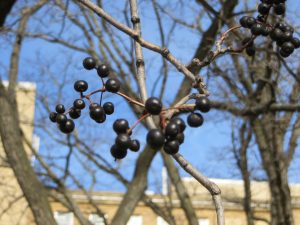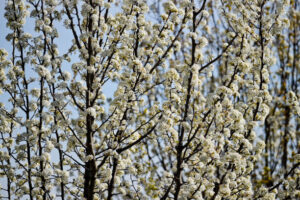
Getting to Know Your Forest Health Team: Mary Bartkowiak on Woodland Invasive Species
by Denise Thornton
Invasive plants are a constant challenge for anyone working to manage Wisconsin’s forests, and with over 9 million acres of Wisconsin in the hands of nonindustrial private land owners, our individual decisions can make a real difference. Wisconsin DNR Forest Health Specialist Mary Bartkowiak, stationed in Rhinelander, is familiar with invasive threats throughout the state. Here’s her overview for landowners.
COMMON INVASIVE TREES AND SHRUBS

Buckthorn, a small tree whose twigs often end in thorns, remains a huge concern in Wisconsin. It degrades native habitat in oak forests, riparian woods, savannas and prairies and thrives on well-drained soils. Like many invasives, it outcompetes native plants by leafing out early and staying green longer. “Once established, buckthorn contributes to erosion because it doesn’t hold soil in place as well as the natives it outcompeted,” says Bartkowiak.

Honey Suckle, a multi-stemmed shrub up to 12 feet tall, is another strong invader outcompeting just about everything. “It I can make a lovely hedge,” Barkowiak says, “but if you can – try to remove it from your landscape.”

Japanese Barberry, a spiny shrub 2-3 feet tall, is an aggressive invader. It grows very densely, creating deep shade and high humidity close to the ground. “We are finding that in Japanese Barberry infested woodlots, there is a higher rate of tick-borne lime disease,” says Barkowiak. “If you are a small animal like a mouse (a vector of lyme disease) it’s a favorite place to hang out.”
COMMON CONTROL METHODS FOR WOODY INVASIVES
For information on what herbicides to use, check out the fact sheets for individual plants at the Wisconsin First Detector Network
- Foliar treatment – a light mist of herbicide on leaves
- Basal bark treatment – directly spraying the bark or stem, and especially useful for buckthorn. Include a bark oil that helps the herbicide penetrate.
- Cut and swipe works for smaller bushes and trees — it’s Bartkowiak’s favorite method. “In fall, cut stems and swipe immediately with herbicide. It’s important to do this in fall,” she emphasizes, “because in spring the majority of a plant’s flow is up from its roots and will push herbicide out. In fall the shrub has spent all summer making food and is storing it in the roots, so the movement of nutrients and water is downward. If you cut and dab then, you will get more bang for your buck.”
Another plus is that dabbing really reduces collateral damage from drift. Bartkowiak advises putting blue dye into the herbicide so you can see which stems you have treated.
“A lot of folks like to burn woody debris, but you don’t have to,” she notes. “You can leave it in the woods and start a brush pile. We like folks to leave the debris on site because berries may drop off and spread along the route from your property to wherever you are hauling them.”
Bartkowiak says, “We are doing combinations of treatments. We go into an area and work from the outside, working inward, for an infestation. We do cut and swipe. Two years later you will have a flush of seedlings, and you can do a foliar spray or hand pull.”
If you do chose to pull them out of the ground, you should go back and check the area because you have disturbed the soil, and that is where invasives first take root.
COMMON HERBACIOUS INVASIVES

Garlic Mustard is an opportunistic plant. “It sees disturbed soil as the perfect place to grow. It is a rapid invader and a serious threat to our forests,” says Bartkowiak. It is a prolific seed producer with high germination rates. It produces biochemicals that are harmful to other plants and also negatively impacts mycorrhizal fungi (essential to many native plants) in the soil.
“We are starting to think that climate change is going to strengthen garlic mustard,” Bartkowiak says. “The seasons are shifting faster than the natives can adapt, and it gives garlic mustard even more of a leg up.The most important thing for garlic mustard is you need to be vigilant. Go out in the spring. Go out several times. We are finding that we’ll do a garlic mustard pull and go back a week later to find a whole new crop emerging. The most important thing is don’t let it flower. Prevent those seeds from developing.”
Good News About Garlic Mustard
Bartkowiak had one piece of good news on garlic mustard. A garlic mustard aphid has been identified in the United States. Because this aphid may help control garlic mustard, the Midwest Invasive Plant Network is working with citizen scientists to map their distribution. You can learn more about these aphids and how to get involved at the Midwest Invasive Plant Network
NEW THREATS

Japanese Stilt Grass has been identified in the Coulee State Experimental Forest in La Crosse County. Its aerial roots make the grass look like it is being held up on stilts, and it has a silver midrib in the leaf that is slightly off center. “This is a ferocious grass with a sprawling habit. It is likely to spread to other areas.

Amur Cork Tree is a handsome tree that is really aggressive. “A lot of people planted it 40 to 50 years ago, but we are finding that where it has escaped into woodlots, it really produces a lot of trees. People thought is was safe to plant only the male trees, but occasionally male trees do morph to produce produce seed. As of 2017 the largest populations of Amur Cork tree were spreading in the forests of Adams, Columbia, and Dunn counties.

Callery Pear Tree was used extensively for urban landscaping in the 1960s and 70s, but it has also escaped to woodlands where it is a strong competitor. “It was supposed to be a terrific tree, and it was supposed to be sterile,” says Bartkowiak, “but it’s like a comic book supervillain that started out good and morphed into something really dark. They are spreading out into woods and along bike trails in the Dane County area.”
